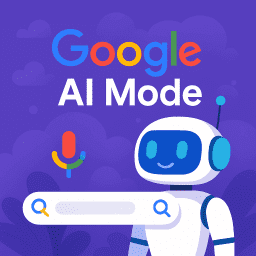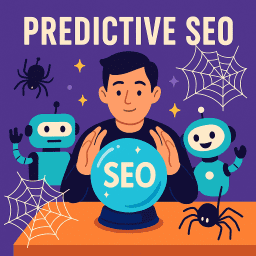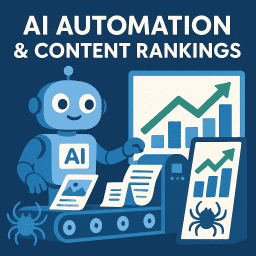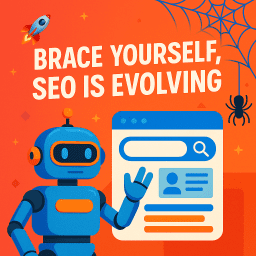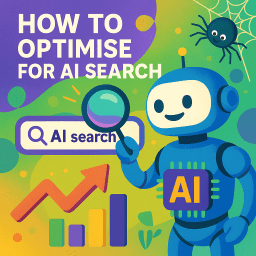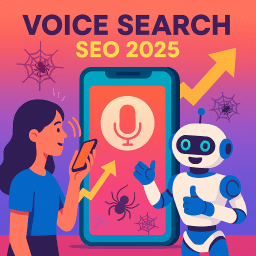Holographic Search: Optimising for Voice, Gesture and 3D SEO
The near-future of search you’ll literally walk through
🚀 You Are There: Searching in 2032
You lift your hand, and a column of glowing search results materialises in the air. No keyboard. No screen. Just a floating carousel of information hovering in your living room. With a flick of your fingers, the results rotate. You glance at a 3D model, and it expands into life-size detail. Your voice says “show me reviews from the last month,” and the hologram instantly updates. Search no longer feels like typing – it feels like stepping into the internet.
Why Holographic Search Is Closer Than You Think
Apple Vision Pro, Meta Quest 3, and Microsoft’s HoloLens are already bringing spatial computing into daily life. Google, Apple, and Meta are investing heavily in AR glasses that layer digital information into your real-world view. Combined with AI-powered voice recognition, gesture control, and 3D modelling, the foundations are already in place.
Holographic search will merge these elements into one seamless interface – blending WebXR/WebAR, AI-personalised results, and real-time multimodal input. Search engines won’t just serve text and links, they’ll serve interactive experiences.
What Search Results Will Look Like in 3D
- Interactive 3D product previews you can rotate and inspect
- Virtual rooms displaying grouped results by theme or intent
- Gesture-activated “expand” for deeper details
- Voice commands to refine and compare results instantly
- Eye-tracking that triggers context expansion
The SEO Impact: From Blue Links to Spatial Presence
SEO will move beyond text-based SERPs to optimising for spatial visibility. Your goal won’t just be to rank – it will be to exist in the right 3D context and provide assets AI can use.
Expect to optimise for:
- 3D assets – product models, interactive infographics
- Voice-first optimisation – natural language queries
- Gesture navigation – visual hierarchies without scrolling
- Entity SEO – building semantic authority
- Interaction signals – dwell time in holographic space
How to Optimise for Voice, Gesture, and 3D
- Invest in 3D content creation
- Use AR-ready formats like glTF, USDZ
- Implement schema for voice, images, and spatial data
- Design experiences for look, point, and speak
- Ensure instant load speed for 3D assets
Why “Position Zero” Becomes “Position Anywhere”
Results could appear above, beside, or around the user. Rankings will adapt dynamically based on voice commands, location, and behaviour. SEO becomes about eligibility and adaptability, not just fixed positions.
Risks and Challenges
- Accessibility for users without AR devices
- High content creation costs
- New analytics for tracking interactions
- Privacy concerns with eye-tracking data
Opportunities for Early Movers
Brands producing 3D content early will dominate virtual “shelf space” in holographic search, just as early adopters of rich snippets once did. Preparing now ensures you’re visible when this shift arrives.
What the Experts Are Saying
Cathy Hackl, Chief Metaverse Officer at Journey: “Spatial computing is not coming – it’s here. The brands preparing for 3D and AR search now will own tomorrow’s attention.”
Rand Fishkin, Co-founder of SparkToro: “SEO has always been about adapting to how people find and consume information. Holographic results just take that adaptation into another dimension – literally.”
John Mueller, Google Search Advocate: “We don’t design search for one device or format anymore. Voice, AR, gesture… they’re all part of the same ecosystem.”
Final Thoughts
Holographic search is not some far-off fantasy – it’s the logical next step in how humans and machines exchange information. Within a decade, the keyboard-and-screen model will feel as outdated as dial-up internet.
SEO professionals who adapt to this shift early will have a huge advantage. The skills to focus on now include 3D asset creation, entity SEO, and multimodal optimisation for voice, gesture, and eye-tracking inputs.
Brands that treat holographic search as a novelty will get left behind; those that take it seriously will secure prime placement in the most immersive search experience ever created.
The future of SEO will be measured not just in clicks, but in presence – whether you are there when the user steps into the search space.
Also read:
The Last Click: How AI Erased SEO and Rewired the Web
FAQs About Holographic Search and SEO
What is holographic search?
Holographic search is a type of search interface that uses AR or mixed reality to display results as interactive 3D objects in physical space, navigated by voice, gesture, and eye movement.
How soon will holographic search become mainstream?
Early adoption will likely start within 5–7 years, driven by AR glasses and spatial computing devices, with broader uptake in the following decade.
Will traditional SEO still matter?
Yes, but it will evolve. Entity SEO, 3D content, and multimodal optimisation will become just as important as keywords and backlinks.
Do I need 3D models for holographic SEO?
Not immediately, but brands creating 3D-ready assets now will have a head start when search engines integrate them.
How will rankings work in holographic search?
Rankings will be fluid, with results positioned in spatial layouts that adapt to the user’s behaviour and preferences.
Can voice search optimisation help with holographic SEO?
Absolutely. Voice queries will be a primary interaction method in holographic search environments.
What file formats are used for AR content?
Common formats include glTF and USDZ, which are supported by most AR platforms.
Will this make SEO more expensive?
Possibly. Creating and maintaining 3D content and spatial experiences can require more resources, but early investment can lead to long-term visibility gains.
How do I measure performance in holographic search?
Analytics will track interaction signals such as dwell time, object manipulation, and repeat engagement instead of just page views.
Who will lead in holographic search technology?
Likely leaders include Google, Apple, and Meta, with possible competition from AI-native platforms.
Video Recap – Holographic Search — Voice, Gesture & 3D SEO Explained
Imagine search results floating in front of you – move them with your hand, talk to them, and explore them in 3D. In this video, I’ll show you what holographic search means for SEO – and how to get your brand ready for this new reality.



